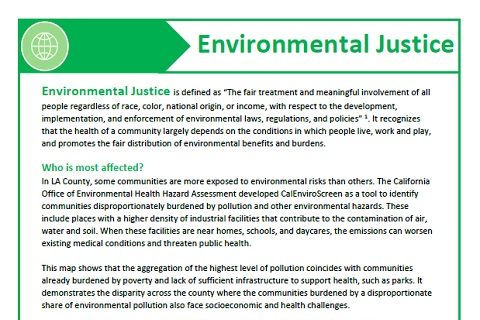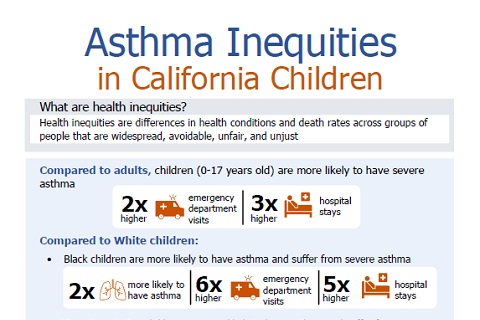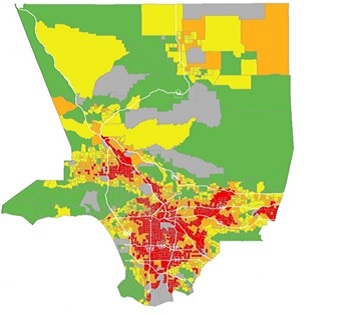About Environmental Justice
Everyone deserves to live in a clean, healthy environment because the environment around us affects our health. Many Los Angeles County neighborhoods have business and industry mixed in with homes, schools, day cares, and elder care facilities. We know that poor people and people of color are more likely across the United States to live near polluting factories and are exposed to more pollution than wealthier communities and white communities. In the early 1980s in the United States it was recognized that hazardous waste sites are found more often in low-income communities of color than in wealthier and predominantly white communities.
With that realization, local, state, and federal agencies also recognized the need to work towards environmental justice.
As defined by the Federal Environmental Protection Agency, environmental justice is "the fair treatment and meaningful involvement of all people regardless of race, color, national origin, or income, with respect to the development, implementation, and enforcement of environmental laws, regulations, and policies."
For more information on Los Angeles County's efforts to achieve environmental justice, please visit the Center for Health Equity website or see the Center for Health Equity Fact Sheet (English) | Hoja Informativa del Centro de Equidad en Salud (Español)
Learn about opportunities with the Environmental Health Division of LA County Public Health: Jobs and Internships
Learn about LA County Public Health's Youth Advisory Council

Center for Health Equity Fact Sheet

Asthma Inequities in California Children
Communication Resources for Agencies
- Plain Language Guide, "Say it Right the First time". Learn practical tips about the three principles: audience, content, and design. See the checklist on page 39.
- Create easy-to understand materials with "Simply Put" See the checklist on page 29.
- Assess a document -take this quiz while you're developing a document to identify areas of improvement, see the CDC Clear Communication Index Widget

Identifying Burdened Communities
The State Office of Environmental Health Hazard Assessment (OEHHA) created a way to measure the unfair differences in pollution and health burden that we see in communities throughout California. The tool they created, called CalEnviro Screen, ranks each community in the state. It is easy to see how pollution and the potential health effects of pollution are distributed across our communities because the CalEnviro Screen displays the rankings in a color-coded map.
Each community's rank is calculated by combining two factors: the amount of pollution present and the characteristics of people living in the community. You can use the mapping tool to see your community’s rank and look further into the factors that make up your score. For more information, visit OEHHA’s website at the links below.
- Learn more about CalEnviroScreen website (English) | Sitio Web CalEnviroScreen (Español)
- Learn more about Fact Sheets on CalEnviroScreen (English) | Hojas Informativas en CalEnviroScreen (Español)
- Find your community on CalEnviroScreen (English) | Encuentra Tu Comunidad en CalEnviroScreen (Español)
- Video about CalEnviroScreen




